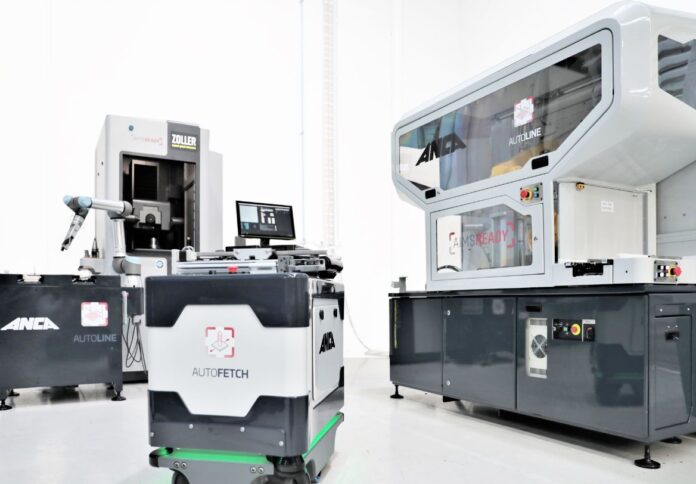
Media Release by ANCA
Melbourne-based advanced manufacturer ANCA has launched industry first automation technology capable of helping companies combat rising costs, while also addressing the growing skill shortage.
ANCA’s Integrated Manufacturing System (AIMS) automates repetitive tasks, reducing demanding workloads and allowing employees to focus on more critical work or upskill themselves in other manufacturing processes.
The technology has also been proven to help improve production efficiency and reduce costs, at a time manufacturers are feeling the pinch from inflationary pressures amid rising energy prices.
AIMS utilises smart automation to streamline production by linking separate processes to each other and other factory IT systems while utilising integrated autonomous robots to transfer material between processes, replacing the need for human operators to carry out routine complex tasks.
ANCA Manufacturing Operations Manager, Mark Patman, explains this allows customers to upskill their workforce to perform more critical and complex tasks, while simultaneously helping contribute to wage growth.
“We’ve found our customers get the most value out of automation targeted towards repetitive tasks that can occur alongside value-adding individual skills,” Patman said.
“Keeping your high-value processes fed with material is always challenging when manual handling is required, AIMs slots in seamlessly to automate routine processes while removing the need for manual handling.”
A recent report commissioned by tech giant Google found automation could deliver a $2.2 trillion boost to Australia’s national income.
“Our customers continue to look for custom solutions for increased automation in their operations and AIMS is ANCA’s holistic response; a tangible option for a smarter factory,” Patman said.
ANCA’s unique technology considers the whole value chain within the factory, rather than separating it into individual elements of design, preparation, assembly, packing and shipment.
This approach helps avoid sub-optimisation, bringing together all the moving parts of manufacturing under a single efficient ecosystem and delivering complete manufacturing management, with an end-to-end view of a facility’s performance.
ANCA AIMS brings benefits of fully automated “lights-out” manufacturing under a single sophisticated system.
“Combined with our existing technology offerings, which are used to create and improve products in everyday life such as cars, medical devices, airplane engines and even mobile phones, our new technology AIMS can help plug the skills gap in the advanced manufacturing industry,” Patman said.
“Automation and robotics, such as AIMS, are changing the way manufacturing industries work – we can focus on working smarter to create efficient results, unlocking the ability for employees to focus on critical tasks and improve plant processes, rather than work on repetitive tasks.”
Additionally, ANCA’s machine tool technology can seamlessly integrate with AIMS and perform the most complex and exacting processes – sometimes more precisely than the most highly skilled operators.
Offering a modular solution, AIMS can also be deployed in stages, allowing for an easy, gradual and smooth transition from traditional to automated and integrated manufacturing.
ANCA recently presented the first operational demonstration of AIMS at an international technology tradeshow in Stuttgart, Germany.
The demonstration was the first of its kind for the industry, receiving significant interest from manufacturers in Europe, Asia and the Americas in the technology that was designed and engineered in Australia.
“It really is a big leap for the industry and taking new technology first to market is how we have achieved global leadership,” said ANCA Co-Founder Pat Boland.
“We received numerous verbal offers on the spot for a highly complex system which demonstrates the appeal of AIMS. Ironically, we now must resource our engineering team to refine the technology – and that is a challenge as finding good talent is exceedingly difficult at the moment.”

















